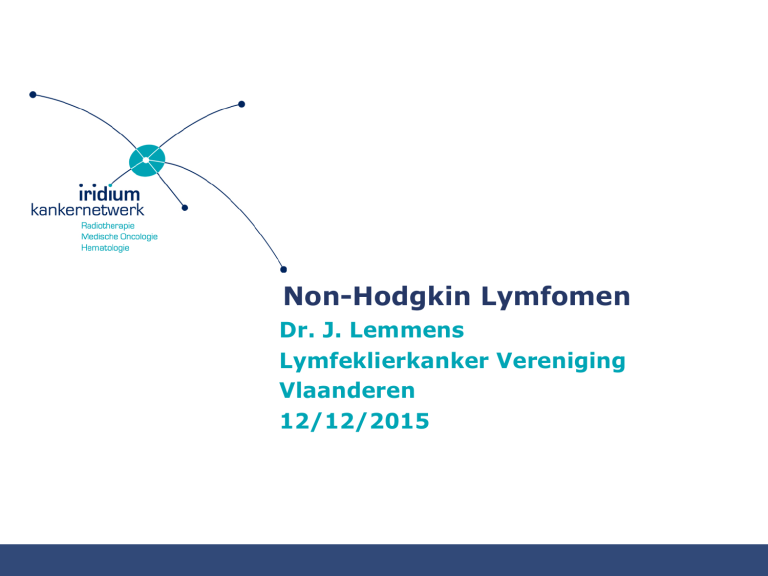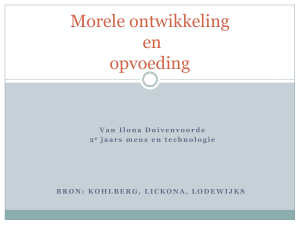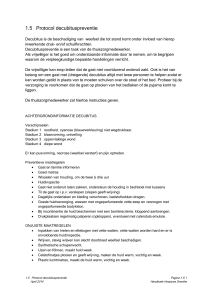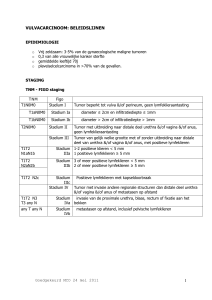
Non-Hodgkin Lymfomen
Dr. J. Lemmens
Lymfeklierkanker Vereniging
Vlaanderen
12/12/2015
Inleiding
•
•
•
•
•
•
•
Hematologische kankers: ± 6% van totaal.
Lymfomen ± 4 % van alle Ca ( ongeveer 300000 nieuwe
gevallen in de wereld/j), waarvan 1/3 agressieve lymfomen.
Incidentie stijgt met leeftijd
–
0,3/100000 (35-39j)
–
26,6/100000 (80-84j)
Bepaalde types ifv leeftijd (Burkitt lymfoom bij kinderenfolliculair NHL bij volwassenen)
Man > Vrouw
Ziekte komt vooral voor in USA en W-E, minder in Azië en
Oost-Europa.
Stijgende incidentie 3-5%/jaar, reden is ?
NHL: toenemende incidentie
Epidemiologie NHL
•
•
•
•
Zevende meest frequente kanker in wereld
Ongeveer 301000 nieuwe gevallen/jaar
Man>vrouw
Incidentie stijgt met leeftijd
NHL versus Hodgkin
Lymfomen: oorzaken
•
•
•
Immuunziekten (aangeboren, auto-immuun vb reuma,
orgaantransplantatie, immuunsuppressiva, chronische
ontstekingen)
Zwaarlijvigheid
Virussen:
–
•
•
•
Hep B, C, EBV, HHV-8, HTLV-1, HIV
Bacteriën
–
Borrelia Burgdorferi: huidlymfoom
–
Chlamidia Psittaci: traanklier/orbitalymfoom
–
Helicobacter pylori: maaglymfoom
–
Campylobacter jejuni: darmlymfoom
Pesticiden, benzeen, tabak?
Bestraling
Lymfomen: symptomen
•
•
•
•
•
•
•
Soms geen (toevallige vondst klier)
Hinderlijke klier(en)
Pijn
Verminderde eetlust
Vermagering (-10%/6m = B-symptoom)
Koorts (= B-symptoom)
Zweten, ‘s nachts (= B-symptoom)
Lymfomen: diagnose
•
Lichamelijk onderzoek: gewichtsmeting, klieren,
zwelling van lever of milt, orgaanaantasting
•
Labo: normale bloedaanmaak?, lever- nierfunctie?, LDH
•
Verse klierbiopsie (microscopie, immunohistochemie
“flow-cytometrie”, soms chromosomenonderzoek, soms
DNA)
•
Beenmergpunctie/Botbiopt
•
PET/CT-scan
•
CT thorax, CT abdomen, (CT hals)
Celdeling
Celdeling
Celdeling
Chromosoom/moleculair onderzoek
Inleiding : CD20 expressie
Bone Marrow
Pluripotent
stem cell
Lymphoid
stem cell
Blood, Lymph
Pre-B cell
B cell
Activated
B cell
Plasma
cell
CD 20
Press OW. Semin Oncol. 1999:58–65.
Chromosoom/moleculair onderzoek
•
Link tussen gen-afwijking en tumorale groei:
–
Translocatie
Gemodifiëerd gen
Mechanisme
–
t(14;18)
bcl-2
anti-apoptose
–
t(2;8)
c-Myc
cel cyclus++
en cel diff.--
–
t(11;14)
cyclin D1
suppr.cel cycl.---
–
3q27
bcl-6
transcriptie++
Lymfomen: WHO classificatie
•
WHO classificatie met klinische, microscopische, flowcytometrische en moleculaire gegevens:
–
1998, 2008 (Update 2016):
•
Lijst van ± 30 ziekte-entiteiten
–
B-cel maligniteiten
»
»
–
T-cel maligniteiten
»
»
–
Precursor- B
Mature (Perifere) B-cel (12 entiteiten )
Precursor- T
Mature (Perifere) T-cel (13 entiteiten)
Hodgkin
Non-Hodgkin lymfomen
Mantle cell (6%)
Peripheral T cell (6%)
Other subtypes (9%)
Indolent (35%)
Composite
lymphomas (13%)
DLBCL (31%)
Armitage J, et al. J Clin Oncol 1998; 16:2780–2795.
Lymfomen: : bepaling ziekte uitbreiding
(stadiëring)
•
Gemodif. Ann Arbor systeem:
–
Stadium I:
• Een enkele klierregio is aangetast (of 1
orgaanlocalisatie E)
–
Stadium II:
• Twee of meer klierstations (zelfde zijde middenrif) ± 1
E
–
Stadium III:
• Klieren aan beide zijden van middenrif (±1 E)
Stadium IV:
• Uitgebreide aantasting een of meer organen
A/B
–
•
Lymfomen: stadiëring met PET/CT en
beenmergpunctie/botbiopsie
lymfomen: stadiëring
Lymfomen: prognose
•
•
•
•
Leeftijd
Algemene conditie van de patiënt
Uitbreiding ziekte (stadium)
Agressiviteit van ziekte
Prognose bij diffuus grootcellig NHL
•
Internationale NHL Prognostic Index
• Risico factor
Ongunstig
– Leeftijd
>60
– Stadium
III of IV
– Aantal extranodale loc.
2+
– Performance status
ECOG 2+
– LDH
abnormaal
• Categorie
Aantal risicofactoren
– Low
0,1
– Low-intermed.
2
– High-intermed.
3
– High
4,5
Prognose bij diffuus grootcellig NHL
•
International Prognostic Index
–
Risk group
•
•
•
•
Low
Low interm.
High interm.
High
3j zonder ziekte>
87%
75%
59%
56%
3jOS
91%
81%
65%
59%
Prognose bij folliculaire lymfomen:
FLIPI score
•
•
Risico factoren:
–
Leeftijd > 60 jaar
–
Stadium III-IV
–
LDH abnormaal
–
Hb < 12 g/dl
–
>4 klierstations aangetast
Prognostische score:
–
Good prognosis (0-1 factor): 10j overleving:
71%
–
Intermediate (2 factoren): 10j overleving:
51%
–
Poor Prognosis (>2 factoren): 10 j overleving:
36%
Diffuus grootcellig B-NHL
•
•
•
•
•
•
•
Belangrijkste subtype
lymfeklierkanker
Heel wisselende presentatie
Meestal snel groeiende
klieren, meestal ptn ziek
Levensbedreigend (m) zo
onbehandeld
Geneesbaar met
chemotherapie:
CHOP-Rituximab 8 kuren
Soms 3-6 kuren +bestraling
bij beperkt stadium
Therapie: diffuus grootcellig B-cel NHL
•
•
•
Meer dan 15 jaar is R-CHOP/3 weken de standaard
–
Rituximab 375 mg/m2 IV d1
–
Cyclofosfamide 750mg/m2 IV d1
–
Adriamycine 50 mg/m2 IV d1
–
Vincristine 1,4 mg/m2 IV d1(max 2mg)
–
Prednisone 100 mg/d PO d1-5
Meer agressieve combinaties niet meer doeltreffend
(tenzij “DA-EPOCH” voor sommige subtypes)
Upfront hoge dosis chemotherapie met stamceltransplantatie
soms beter voor prognostisch ongunstige subgroepen
Monoclonaal antilichaam Mabthera
•
Specifiek gerichte therapie
•
Mabthera bindt aan CD20 op
lymfoom-celoppervlak en triggert
immuunafweer, werkt direct
toxisch op de cel en verhoogt
efficiëntie van chemotherapie
•
Bij eerste infusie kan allergische
reactie optreden of griepaal
syndroom
Therapie: oudere ptn (GELA-LNH 98.5)
NB Update 7J FU: curves blijven divergeren
Standaard behandeling DLBCL (en FL gr 3)
•
•
Stadium I-II non-Bulky: (3-)6x CHOP + rituximab/21d en Radiotherapie
Stadium II Bulky-IV:
- bij IPI low en low–intermediate: 6-8x CHOP + rituximab/21d
- bij IPI intermediate-high en high, en ≤ 65j:
6-8x CHOP + rituximab/14 d of variant (+ groeifactoren)
- bij IPI intermediate-high en high, en > 65j:
6-8x CHOP + rituximab/21d
•
•
•
•
•
Bij hartpatiënten: 3x CHOP/rituximab + bestraling als alternatief voor full
chemotherapieprogramma
Bij bejaarde patiënten: aangepast schema (mini-CHOP)R (zie verder)
Soms intensificatie met upfront hoge dosis chemo en autologe
stamcelTx
Bij lokalisaties in testis, oogkassen en sinussen: hersen-profylaxie
Bij herval/refractaire ziekte: nieuwe chemo (“DHAP+ rituximab of ICE +
rituximab”), nadien hoge dosis chemo + stamceltransplantatie
Standaard behandeling DLBCL
•
Behandeling van de oudere ptn (Nederlandse registratie, 2000):
–
Leeftijd
•
•
•
•
•
<60
60-64
65-69
70-74
>75
CR(%)
5j OS(%)
nle levensexpect (j)
65
65
53
48
39
52
43
34
27
14
20
17
13
10
8
Rol van PET: status na 2 cycli
1.00
PET neg (n = 49) 2-yr EFS = 80%
Proportion
0.75
PET pos (n = 32) 2-yr EFS = 46%
0.50
0.25
p = 0.0003
0.00
0
1
me
o
c
t
u
:
o
e
i
t
d
c
i
u
st
2
ed
r
1
e
p
t
0
n
2
o
t
d
ce
d
o
e
e
r
o
l
l
i
r
B
fa
o
T
n
Maa
E
g
P
re
P
m
i
,
r
P
e
O
Int
H
C
R
r
e
t
f
A
2
Years
3
4
5
R-CHOP 21, R-CHOP 14 of iets beter?
100
80
Transplantation
60
40
Conventional treatment
20
Overall survival (%)
Event-free survival (%)
100
Hervallen NHL: Hoge dosis chemo+
autologe stamcelTx is standaard zo NHL nog
chemo-gevoelig is
p = 0.001
0
0
15
30
80
Transplantation
60
40
Conventional treatment
20
p = 0.038
0
45
60
75
90
DFS:Months after randomisation
0
15
30
45
60
75
90
OS:Months after randomisation
Philip T, et al. NEJM 1995; 333:1540–1545.
Folliculair NHL
Folliculair NHL: inleiding
•
•
•
•
•
•
•
•
•
Tweede meest voorkomend NHL.
Incidentie neemt toe (X2 in 30 jaar tijd)
Meestal weinig agressief
Agressiviteit wordt microscopisch gegradeerd (graad
1,2,3a,3b) in functie van aanwezigheid grote agressieve
cellen (centroblasten)
FL graad 3 moet worden behandeld als DLBCL
Stadiëring volgens gemodifiëerd Ann Arbor systeem in I,
II, III, IV A/B
Meeste ptn hebben uitgebreid stadium, slechts 10-15%
stadium I en II
Mediane overleving 8-10 jaar
Prognostische index: FLIPI score
Folliculair NHL: therapie
•
•
Stadium I en beperkte II: Bestraling kan genezing bekomen in 45-80%
van ptn
Stadium II-III-IV:
–
Wait and see
–
Chlorambucil (leukeran tabletten)
–
Chemo-immunotherapie intraveneus
• “CVP”-Rituximab,
• “CHOP”-Rituximab,
• Steeds met 2 jaar rituximab/2 maanden als
onderhoudsbehandeling
–
Rituximab only
–
Intensieve therapie met “eigen stamcellen”-transplantatie
–
Radio-immunotherapie: Zevalin
–
Nieuwe behandelingen (zie verder)
Folliculair NHL: onderhoudstherapie
Externe bestraling vs RIT
External
Beam radiation
Radioimmunotherapy
90Y
Ibritumomab Tiuxetan (Zevalin)
Ibritumomab
Monoclonal
antibody
– Murine monoclonal
antibody parent of
rituximab
Tiuxetan (MX-DTPA)
Chelator
Radionuclide
– Conjugated to
antibody, forming
strong urea-type
bond
– Stable retention of
90Y
Folliculair NHL: therapie
•
Resultaten van RT in FL stadium I-II
–
Ref
n°ptn
observ. tijd
relapse free
–
Pendlebury
58
10
43
–
MacManus
177
15
44
–
Stuschke
117
5
83(I)/44(II)
–
Murtha
66
10
-
–
Wilder
80
15
66(I)/26(II)
–
Ott
58
10
64
–
Guadagnolo
106
10
46
Folliculair NHL: nieuwe therapieën
•
Veel nieuwe behandelingen zijn beschikbaar of op
komst… alleen de terugbetaling is een probleem!
–
Chemotherapie: Bendamustine
–
PI3K-inhibitoren: Idelalisib (“Zydelig”), Copanlisib,
Duvelisib
–
Immunotherapie: Obinutuzumab, anti PD1/PDL1
–
Proteasoominhibitoren: Ixazomib
–
Bruton’s tyrosine kinase blokker: Ibrutinib, APC196
–
PKC beta blokker: Enzasturin
–
Studies!
•
•
IPI 145 (duvelisib) + obinutuzumab of rituximab
DART dual affinity re-targeting proteine (CD19 +CD3)












